We call them zip ties, zap straps, or cable ties, and sometimes it seems that much of our modern life is held together by them. These thin plastic ratcheting straps have a lot of utility and should be included in any bug out bag, survival kit, or other outdoor kits.
This article is a list of 15 survival uses for zip ties but in reality, their utility is only limited by your imagination.
1. Secure Prisoners
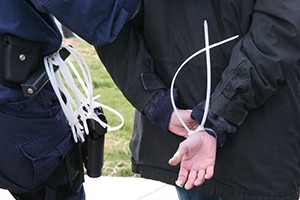 Zip ties are so useful as handcuffs that law enforcement around the world uses a beefed-up version of the standard zip tie to secure prisoners.
Zip ties are so useful as handcuffs that law enforcement around the world uses a beefed-up version of the standard zip tie to secure prisoners.
Using zip ties to restrain a human being must only be used in accordance with the laws, rules, and regulations of your specific area.
This is not something that should be taken lightly, since zip ties can cause a significant amount of tissue damage if tightened too much.
It is important to realize that the commercially available zip ties are very easy to get out of, if you know what you are doing.
Related: Scare Them Off Or Shoot Them Dead?
2. Cable Ties
This is the most obvious use because this is quite literally what these ties are designed to do. Be it electrical wires or hoses, use zip ties to secure these in place and out of harms way.
3. Lashing
If you run out of or do not have cordage, then zip ties can be used to secure most things together that other cordage would.
This is not always a good option though, since zip ties and cordage work differently. Zip ties also can not be loosened easily so what you’ve lashed together can not be adjusted or undone without cutting the zip tie.
4. Repair
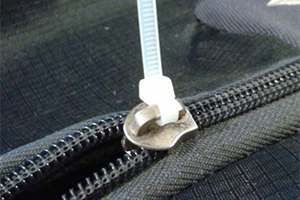 I’ve used zip ties so often to repair gear that I have buckles that have been held on with zip ties for close to two decades. You can also use zip ties to join together the two sides of a blown-out zipper or to reattach straps to packs or gear bags.
I’ve used zip ties so often to repair gear that I have buckles that have been held on with zip ties for close to two decades. You can also use zip ties to join together the two sides of a blown-out zipper or to reattach straps to packs or gear bags.
I’ve even used zip ties to sew together large tears in packs or gear bags.
Related: 15 Pieces of Crucial Urban Survival Gear
5. Splint
Instead of paracord, duct tape, or bandages, you can secure a splint to a fractured arm, leg, or finger by using zip ties. Just don’t let the ties cut off circulation.
6. Organizing Gear
Zip ties can be used to organize loops of paracord, pens, small items, etc. A wrap of zip tie can be used to keep similar small items bundled together and easier to organize and stow.
You can also use them to compress rolls of clothing to save space and make your gear more organized.
7. Secure Your Boots
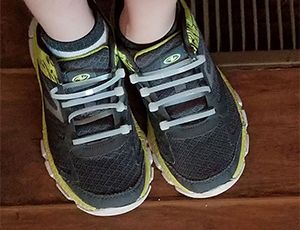 We have all had boot laces blow out and using a zip tie to secure the eyelets together is a good option.
We have all had boot laces blow out and using a zip tie to secure the eyelets together is a good option.
Unfortunately, the only adjustment you can make is to tighten the straps which limits your ability to adjust the fit of your boot or shoe.
Another major downside is that you’ll have to cut the ties every time you need to remove your footwear.
8. Hanging Items
A simple loop of zip tie can be used to hang items from anything that the zip tie is long enough to be wrapped around.
I like to make a loose loop out of a zip tie and secure it to whatever object that I want to hang something from with another zip tie. I then use a carabiner to attach the lantern, bag, pouch, etc. to the loop. This allows me to be able to use the same hanging point for multiple objects.
9. Trail Markers
Attaching a colored zip tie to a branch can act as a low-profile trail marker. These are good because they are not as obvious as a strip of flagging tape wrapped around a tree. For the same reason, they are not always ideal because they are easy to miss.
This method of marking is great for marking the location of a hidden cache because it is easy to miss if you do not know what to look for.
10. Tamper-Resistant Lock
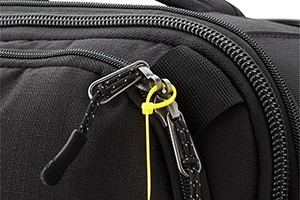 Securing the two ends of a zipper together with a zip tie instead of a padlock is a good way to create a tamper-resistant way to keep your belongings secure.
Securing the two ends of a zipper together with a zip tie instead of a padlock is a good way to create a tamper-resistant way to keep your belongings secure.
To gain access to the contents of the bag one would have to cut the zip tie, go through your stuff, and then replace the zip tie.
If you use zip ties of a unique color, then it would be even more unlikely that a potential thief would be able to cut the tie, and re-secure the zipper with a new tie.
Related: Home Security Tips From an Ex-Burglar
11. Make a Handle
A loop of zip tie strapped to a gear bag, a bundle of branches, water containers, etc. can make a good improvised handle. Zip ties are also great for repairing handles that have broken off too.
One point to note is that zip ties are very narrow and can cut into the skin if carrying heavier loads. Wear gloves or wrap the makeshift handle in fabric or leather and save your hands.
12. Attaching Gear
I can not count the number of times that I have attached gear to a pack, web gear, belt, or tactical vest using zip ties. These also work well for reinforcing and adding extra security to MOLLE gear.
I will often secure pouches to packs and molle panels with some zip ties for added security.
13. Make a Spear
Zap strapping a knife to a pole can make a good improvised spear. While I never recommend using a knife in this way, it is a viable option to fashion a quick and dirty survival weapon.
Instead of a knife, you can also secure stone points or spear points made from scrap metal.
Related: How To Make a Glass Arrowhead
14. Tourniquet
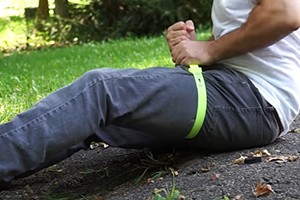 A large and thick zip tie can be used as a last-ditch emergency tourniquet. Since you are guaranteeing tissue damage, you should secure the zip tie as close to the wound as practical.
A large and thick zip tie can be used as a last-ditch emergency tourniquet. Since you are guaranteeing tissue damage, you should secure the zip tie as close to the wound as practical.
This is the kind of intervention that absolutely can result in the loss of a limb and the major issue with using a zip tie as a tourniquet is that it will be very difficult to remove without potential harm to the patient.
The zip tie will also dig into the skin and can cause a lot of additional damage. It needs to be stated again that this is a LIFE OR LIMB decision and not to be taken lightly.
Warning:Do not do this, except in dire life or death emergencies.
15. Added Traction
Tie large zip ties around your boots or shoes to help increase traction on ice and snow, but don’t ratchet it down too tight as to cut off circulation.
You can also use zip ties to secure anything to the sole of your boots that you think might bite into snow and ice. Zip ties can be useful in attaching your boots to improvised snowshoes as well.
There are far more survival uses for zip ties than what is listed here. I am confident that if you throw a bundle or two into your kits and packs, you’ll find an almost infinite amount of uses for them if you use your imagination. What else are you using zip ties for? I’d be happy to find out in your comments below.
You may also like:
12 x More Efficient than Solar Panels? New Inventions Takes (Video)

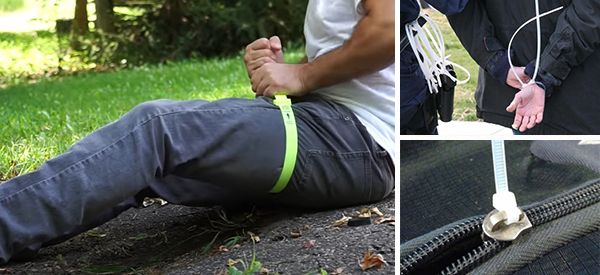








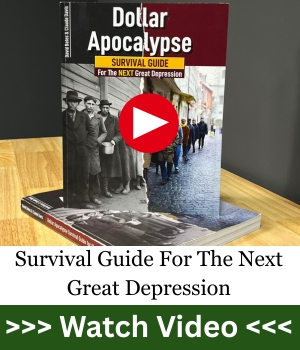












Always good information and ideas at this site. Thank You Michael and Claude
Can also be used for a temporary fan belt !
Heavy duty ties connected nose to tail to form any length necessary, no tools needed except to cut off tie excess.
Won’t run the A/C compressor but WILL turn the water pump &/ or alternator !!
I use zip ties to make a eye or loop in a rope. The load that the eye will be handling dictates how long the running end of the loop is and how big and how many zip ties I use to secure the loop. Of course, were I a real rope master, I would braid the loop, but that is above my pay grade when it comes to rope handling.
As an example, I cover my vehicles that I park outside with car covers. It gets windy here in SoCal, so I tie the car covers down fore, aft and midships. I loop one end of the rope through one side pulling about a three to four inch length though the eye in the car cover. I use three four-inch zip ties to secure the loop. On the other end, I make a loop and use a carabiner to fasten in the other eye of the car cover. There isn’t a lot of stress on the eye in the rope, so the smaller zip ties work quite satisfactorily. I have been using that method for over twenty years and have not had an eye pull out of the zip ties in that length of time
That is the single biggest use I make of zip ties, making eyes in rope and line. The bigger the line the bigger the zip tie I use. There is no set formula that I can apply as to the size and quantity of zip ties I use.
I also use them as handles on water jugs. I put one zip tie around the neck and run another zip tie through the neck zip tie to act as the handle. For that I use rather large zip ties because, as the author stated, they are tough on hands. t seems wasteful to use a 24 inch long zip tie for such a short usage, but unfortunately, wider zip ties seem to only come in longer lengths.
Perhaps I haven’t searched in the right places, but I have never seen a zip tie as wide as the one shown being used as a tourniquet.
I went on line and searched for wide zip ties and wide cable ties and the widest I could find even from sites that dealt only in cable ties was a half inch wide. I wonder that that green strap in the photo is called.
I would advise against securing a tourniquet “as close to the wound as practical”.
Its been a few years but a military Combat Lifesaver course taught me to always go well above the wound because the arteries and veins are fairly elastic and will retract further into the body then one might think.
We were taught to apply the tourniquet as high up on the arm or leg as possible to eliminate any possibility of applying the T too far down.
Side note: I’m skeptical how effective a ziptie would be in mimicking a tourniquet, but that’s just me. I would certainly try if I had absolutely nothing else, though.
You are correct. Tourniquets should be as high on the limb as possible otherwise they may not be effective in stopping the blood flow.
Zip ties are like carrying sanitary napkins in lieu of the appropriate sterile pads to covering wounds. Sanitary napkins are better than your sweaty t-shirt, but large, sterile pads are the ideal.
If you are going to carry something to stop arterial blood flow, carry a real tourniquet. Don’t depend on second best when it comes to life saving devices.
When a loved one is bleeding out is not the time the time to say, “Dang! I wish I had bought the $40 tourniquet instead of this stupid zip tie.”
I searched zip ties and cable ties on line, even a company that only sold ties. The widest ones I could find we’re 1/2 inch.
I use colored zip ties as chamber flags on the firing line to indicate to the rangemaster that my firearm is clear. Bright yellow stands out the most. They are significantly cheaper than most chamber flags and will fit any caliber.
Grainger.com shows ties with their approximate width. The widest I saw was 0.64″ wide. At almost 2/3″, it gets pretty close to the size shown. Looking at the prices per bundle of 50, they ranged from about $176 – $800.
I don’t know about you, but I would rather spend my money on cord, straps, or proper tourniquets. I don’t see a wide zip/cable tie being very high on a prepper’s list of emergency items.
I totally agree. If I had them just laying in my tool box and didn’t have a tourniquet, that might be one thing, but hopefully I will never need 50 tourniquets so popping even $176 for 50 is a waste of money when I can buy genuine tourniquets for between $20 – $30 each and for $176.00 have what I consider to be a lifetime supply of real tourniquets.
If one is making a make-shift tourniquets, belts, pantyhose, stockings, neckties, the orange and black rope commonly called trucker’s rope which I believe is polypropylene and is about 3.8″ thick will all do in a pinch.
Thanks for finding the wider cable ties. I am surprised that the cable tie company’s website didn’t list them, even though that’s all they sell.
I’ve seen the wide ties but nothing but pretty standard ones today.
I’ve secured chicken wire for a chicken pen. I secured a wood frame for a door to a pipe frame.
I Always keep 8″ and 12″ in my tool bucket along with that versatile silver tape.
You can also put zip ties on your bike tires for traction in snow, slush and ice. It actually does work.
That’s a good suggestion for folks who live in snow country.
On bicycle forums there are posts about studded tires for winter bike riding but zip ties are a cheaper work around than mounting studded bicycle snow tires which are not cheap as there is not a huge demand for studded bicycle tires. Most weekend bicyclists put their bike away for the winter in snow country. Only the most dedicated rider braves an icy road on a bicycle.
If I have a hole that is too large for a screw and it needs a shim I have used the left over piece of the zip tie to make the screw hold better. So far these have been better than using a wood dowel, tooth pick or anything else. I keep some of the cut off left over pieces in my tool box.
RR: That’s a great suggestion. I have always wondered what I could do with the end of the zip tie.
We used zip ties to attach lattice 4′ X 8′ pieces to iron poles that my husband put in before he passed on to be with the Lord. We also placed 4’x8′ pieces over the top of what my husband intended to make as a patio – so we have a covered patio with holes in it – guess we could call it a California cover.
We then moved our self-watering pots to under this Ca covered patio and tied the too late tomato plants to the plastic lattice with Zip Ties which made the need for poles for tomato plants useless.
We do live in Arizona where the sun is really hot in the summer, the zip ties do break, however, I just replace them. So glad my son had this idea!!!
Now that it is cooler, I really enjoy looking out my glass door and enjoy my garden!!!